Rate of fire course. Technical features of the Swedish self-propelled gun Bandkanon 1
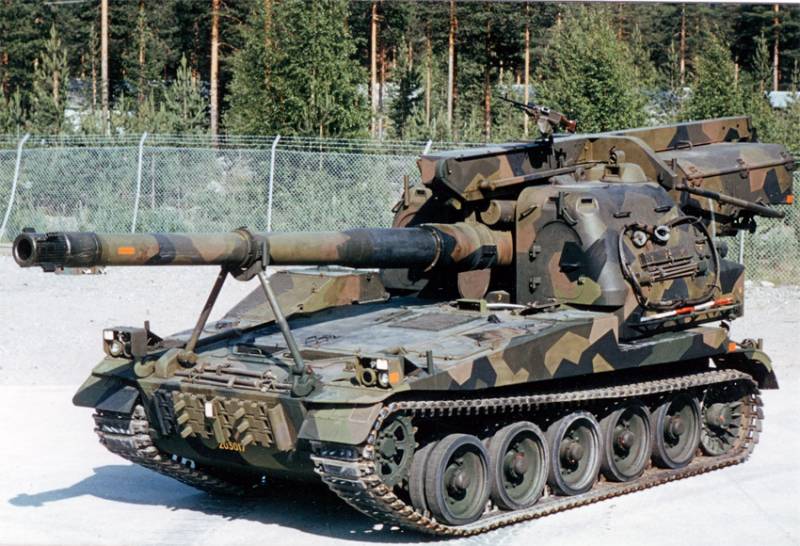
Self-propelled gun Bandkanon 1 in stowed position
In the past, the Swedish ground forces were armed with the 15,5 cm Bandkanon 1 (15,5 cm Bkan 1) self-propelled artillery mount. This combat vehicle differed from other self-propelled guns of that time in its increased fire characteristics. She could fire the entire ammunition load of 45 shells in just 15 seconds, then reload in a few minutes and continue firing. Such capabilities were obtained through the creation of a special design of the artillery system and means of supplying ammunition.
From development to operation
The development program for a promising self-propelled howitzer, which ultimately resulted in the Bandkanon 1, started back in 1949. Serial production of such equipment was planned to begin in the middle of the next decade. Subsequently, the Swedish military department involved various contractors in the work, changed the terms of reference and took other measures. This led to a serious change in the schedule and timing of the work.
Only in 1960, Bofors, Landsverk and Volvo jointly built an experimental self-propelled gun under the designation Artillerikanonvagn 151 with a 150 mm howitzer. It was made on the basis of an available chassis, and the fighting compartment was developed from scratch, taking into account the special requirements of the customer. The Akv 151 self-propelled gun has been tested and confirmed its design characteristics.
However, the army did not accept such self-propelled guns for service. The industry was instructed to rework this project and replace key elements of the combat vehicle. So, the fighting compartment should have been moved to a new tracked chassis, unified with a tank Strv 103. In addition, it was necessary to replace the existing gun with a 155 mm howitzer - while maintaining the auxiliaries and associated characteristics.
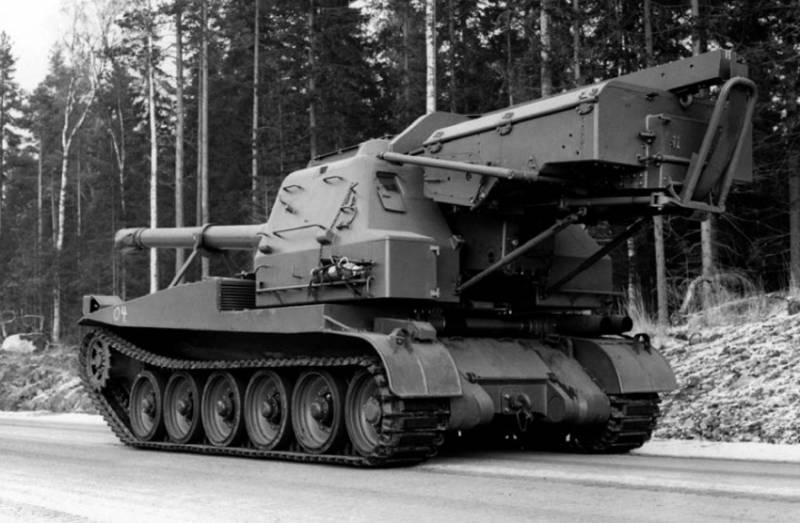
View of the stern, magazine and loading mechanisms
The updated project was prepared in the mid-sixties. After the necessary tests, in 1967 the self-propelled gun entered service under the designation 15,5 cm Bandkanon 1. At the same time, mass production began. Initially, the army planned to build 70 self-propelled guns and rearm a number of units. However, by the time the work was completed, the military budget had shrunk, and only 26 self-propelled guns remained in the plans.
Self-propelled guns entered service with one of the artillery regiments and replaced older types of equipment. 26 vehicles were divided between two divisions. Subsequently, Bkan 1 was transmitted several times to other connections. In addition, at the end of the eighties, the composition of the divisions was revised - there were three of them with eight self-propelled guns in each. As their service continued, the self-propelled guns were repaired and modernized, but in 2003 they were nevertheless written off due to the exhaustion of their service life. Over several decades of operation, rapid-fire self-propelled guns regularly participated in various exercises, but were never involved in real combat operations.
Technical features
The production version of the Bkan 1 was a tracked armored fighting vehicle with a rotating turret equipped with an oscillating artillery system. The self-propelled gun was intended to fire at group and area ground targets in the tactical depth of enemy defenses. Its characteristic feature was the ability to quickly fire up to 15 shots and quickly leave the firing position.
The chassis for the Bkan 1, based on the Strv 103 tank, had a welded hull made of bulletproof/fragmentation armor and had a front-engine layout. Initially, a Rolls-Royce K60 diesel engine with 240 hp was used. In the eighties, a Bkan 1C modernization project was developed, which used a 290-horsepower Detroit 6V-53T diesel engine. The first modification had a manual transmission, the next one had an automatic transmission. The chassis received six road wheels on each side with hydropneumatic suspension; the last pair of rollers were also sloths. On the highway, speeds of up to 28 km/h were achieved, and the range was 30 km.
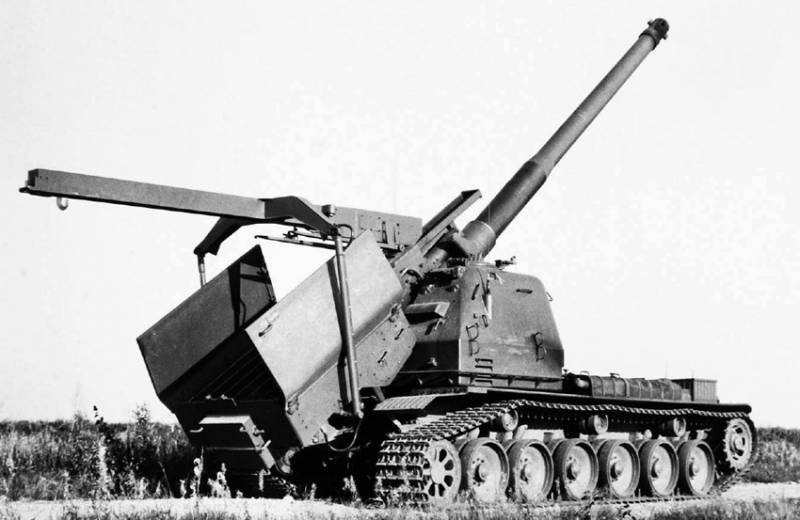
Magazine open for reloading
A tower of an unusual design was placed at the rear of the hull. The hood was divided into two side buildings with crew seats and equipment. Suspended between them was a swinging artillery unit with a gun, a magazine, automatic loading and means of reloading ammunition (on the Bkan 1C its own crane was removed).
The self-propelled gun carried a 155-mm M/60 rifled howitzer with a muzzle brake and a semi-automatic bolt. Vertical guidance was carried out remotely with the ability to fire at large elevation angles. Behind the breech of the gun there was a magazine for 14 unitary shells in a replaceable clip.
The gun could fire directly or from a closed position, for which it had appropriate sights. In the Bkan 1 C modification, an improved navigation system was introduced that simplified topographical reference. We also developed an electronic fire control system with a ballistic computer and a radar projectile velocity meter.
The crew of the self-propelled guns included five people. The driver was located in the hull, directly in front of the turret. The two halves of the turret were manned by a gunner, a commander and two loaders. The latter were responsible for the operation of the automatic loader, loading ammunition, etc.
The total length of the Bkan 1 self-propelled gun in the stowed position (with the gun forward) reached 11 m. At the same time, not only the muzzle of the gun protruded beyond the hull, but also the rear magazine with shells. Combat weight - in the basic version 52 tons or a ton more after modernization.
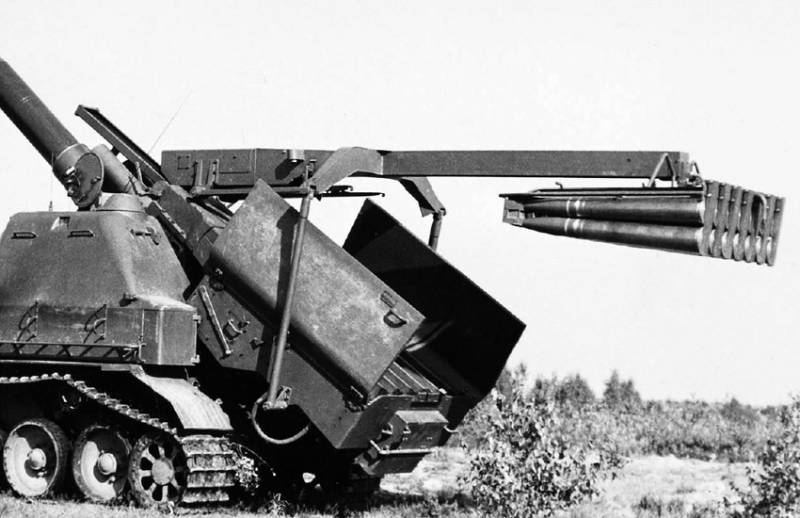
Application of a standard tap
Rate of fire guarantee
The key component of the Bandkanon 1 self-propelled gun was the swinging artillery unit, equipped with a special ammunition supply and loading system. It was she who provided high fire characteristics. At maximum speed, the self-propelled gun could fire up to 15 shots (14 stowed shells and one previously placed in the chamber) in just 45 seconds. When firing at maximum range, the last shot was fired before the first shell had time to hit the target.
The power system had a fairly simple design. Behind the turret and breech there was a movable armored magazine body. Its top was made like a hinged hatch, and at the bottom there was a movable tray with a rammer. In the stowed position, the magazine rose as high as possible, and in the combat position it moved along with the gun, constantly being above the breech of the gun. Above the store there was a fixed boom with means for loading shells.
For reloading, a clip for 14 shells (two rows of 7 pieces each), made in the form of a frame with holding elements, was used. It was placed entirely in the store and removed after emptying. Clips with unitary shots could be transported by any available transport. The process of reloading the clip and preparing the Bkan 1 for firing took no more than a couple of minutes and was carried out using remote control.
During firing, the store's mechanisms moved the shells and one by one brought them to the lower tray with the rammer. When the gun's breech was open, the tray lowered, allowing the projectile to be sent into the chamber, and then returned upward for the next ammunition. After the shot, the cartridge case was thrown out, and a new projectile was fed into the open bolt. The entire recharge cycle took only a few seconds.
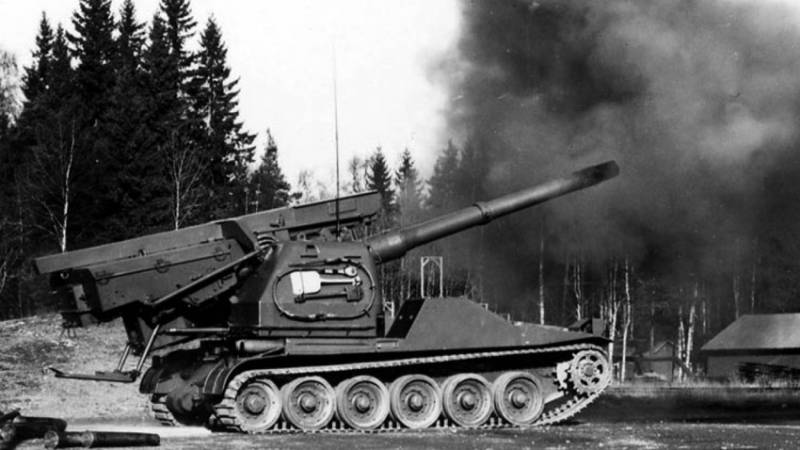
Shot
Thus, preparing the gun for firing and reloading was carried out without direct human participation. The use of specially designed mechanisms and drives of the required power made it possible to obtain the desired speed of work, even despite the large size and weight of 155-mm unitary ammunition.
The process of reloading the magazine seemed to do the same. A large and heavy clip was transferred from the vehicle to the self-propelled gun using its standard crane. It is curious that during the upgrade to Bkan 1C the boom was abandoned, and the fallacy of this decision soon became obvious. Reloading ammunition with a separate crane was a more complex and time-consuming process.
The Bandkanon 1 ammunition included only high-explosive fragmentation shells. Thanks to this, the vehicle did not need devices to recognize the type of projectile in the magazine and could fire at maximum speed. According to some reports, in the future, nuclear weapons could be included in the ammunition load of self-propelled guns, but the Swedish nuclear program has not reached the appropriate stages.
Original solutions
One of the main goals of the 15,5 cm Bandkanone 1 project was to improve all the main fire characteristics, primarily range and rate of fire. Specialists from the Swedish Ministry of Defense and several commercial contractors have found a way to meet such requirements. They proposed a fundamentally new design for the fighting compartment and original means of storing and supplying ammunition.
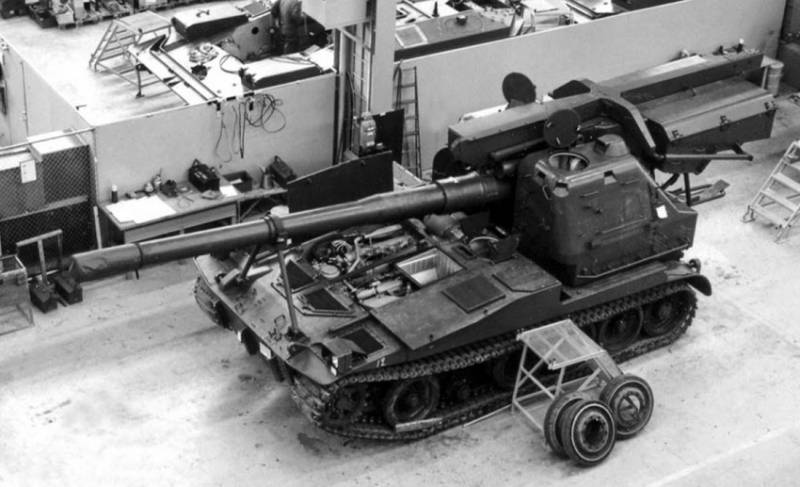
Bkan 1 at the factory
The increase in fire characteristics gave the self-propelled gun a number of important advantages. Thus, the overall fire efficiency of both one vehicle and the unit has increased. The time spent at the firing position has been reduced, which has reduced the risk of falling under return fire. At the same time, detecting the position was quite difficult even when using radar equipment: by the time the projectile trajectory was reliably and accurately calculated, the self-propelled gun had already begun to fold before leaving the position.
Accelerated reloading made it possible to return to shooting faster and also had a positive effect on fire performance. At the same time, the armored vehicle of the first version had its own crane for reloading the clip, which reduced the requirements for transport for ammunition.
In general, the Bkan 1 self-propelled gun of all versions performed well and suited the Swedish army. This technology was abandoned only at the beginning of the 155s, and the main reason for this was the depletion of resources and the impossibility of restoring the equipment. At the same time, the Swedish ground forces did not abandon the idea of a mobile and rapid-firing self-propelled howitzer. Soon this concept was implemented in the form of the Archer self-propelled gun, also equipped with a XNUMX mm gun and automatic reloading.
Information